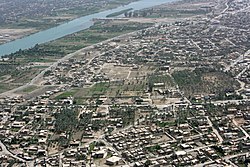Anbar (town)
Anbar
الأنبار Peroz Shapur | |
|---|---|
 | |
 Anbar Anbar's location inside Iraq | |
| Coordinates: 33°22.5′N 43°43′E / 33.3750°N 43.717°ECoordinates: 33°22.5′N 43°43′E / 33.3750°N 43.717°E[1] | |
| Country | Iraq |
| Governorate | Al Anbar |
Anbar (Arabic: الأنبار, romanized: al-Anbār, Syriac: ܐܢܒܐܪ, romanized: Anbar,[2]) also known by its original ancient name, Peroz-Shapur, was an ancient and medieval town in central Iraq. It played a role in the Roman–Persian Wars of the 3rd–4th centuries, and briefly became the capital of the Abbasid Caliphate before the founding of Baghdad in 762. It remained a moderately prosperous town through the 10th century, but quickly declined thereafter. As a local administrative centre, it survived until the 14th century, but was later abandoned.
Its ruins are near modern Fallujah. The city gives its name to the Al-Anbar Governorate.
History[]
Origins[]

The city is located on the left bank of the Middle Euphrates, at the junction with the Nahr Isa canal, the first of the navigable canals that link the Euphrates to the River Tigris to the east.[1][3] The origins of the city are unknown, but ancient, perhaps dating to the Babylonian era and even earlier: the local artificial mound of Tell Aswad dates to c. 3000 BC.[1]
Sasanian period[]
The town was originally known as Misiche (Greek: Μισιχή), Mesiche (Μεσιχή), or Massice (Middle Persian:
